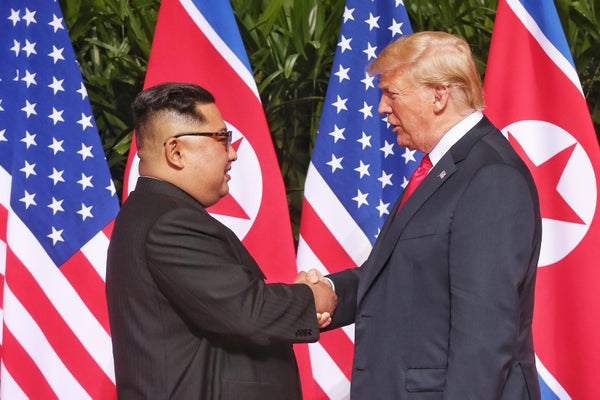Just weeks after Pres. Donald Trump declared North Korea no longer poses a nuclear threat to the world, satellite images revealed the country has spent the past several months upgrading its ability to make solid-fuel ballistic missiles.
Much of the work took place in May—shortly after a meeting between North and South Korean leaders that supposedly ended with a mutual commitment to officially end the Korean War and eliminate nuclear weapons from the Korean Peninsula. U.S. Secretary of State Michael Pompeo arrives in Pyongyang on Friday—his third visit to North Korea’s capital—to work out the details of last month’s Singapore summit with Kim Jong-un. Analysts say, however, the takeaway message from this latest satellite intelligence is that North Korea's leader is highly unlikely to dismantle his nuclear and chemical weapon arsenals within a year, as White House National Security Advisor John Bolton suggested during a July 1 televised interview.
“At a time when we’re hearing Pres. Trump say we pretty much secured denuclearization from the North Koreans and they’re going to start blowing up test sites, we have major expansion at a location that develops technologically advanced missile parts for their weapons program,” says David Schmerler,a research associate at the James Martin Center for Nonproliferation Studies at the Middlebury Institute of International Studies.
On supporting science journalism
If you're enjoying this article, consider supporting our award-winning journalism by subscribing. By purchasing a subscription you are helping to ensure the future of impactful stories about the discoveries and ideas shaping our world today.
Satellite images taken by private company Planet Labs and made public by 38 North—a division of the nonpartisan Henry L. Stimson Center policy researchorganization that monitors North Korea—indicate the country is completing a major expansion of its Chemical Material Institute in Hamhung, the North’s second-largest city. The site produces a composite carbon material for ballistic missiles, some of which are capable of carrying nuclear weapons, says Schmerler, who analyzed the images with Middlebury colleague Jeffrey Lewis. The material is used to make tips for the nose cones of missile reentry vehicles, which must be heat-resistant in order to carry nuclear weapons through the atmosphere intact. It is also used in making the conical nozzles that contain and direct the heat exhaust propelling the missile through the air.
“[Hamhung] is also where they make solid fuel for their missiles, and probably where they make their liquid fuels as well,” Schmerler says. “The site’s expansion is significant because it means they’re going to continue with their missile program.”
Solid-fuel rockets can be especially threatening because they “permit little-to-no-warning launches, thereby raising the danger of surprise attack and severely complicating the ability for layered missile defenses to detect and neutralize incoming missiles,” says Patrick Cronin, senior director of the Center for a New American Security’s Asia–Pacific Security Program. “Liquid-propelled engines can be detected and provide far greater opportunity for early warning.”
The real impact of the Chemical Material Institute’s expansion depends on any agreements Trump and Kim may have reached at their June summit in Singapore. “Was North Korea’s intention to continue what they were doing, albeit less provocatively, by not doing ballistic missile and nuclear weapons testing? If so, then this expansion is just business as usual for the North Koreans,” Schmerler says.
It is important that any U.S. negotiations are founded on a “solid understanding of the structure of North Korea’s solid-fueled missile program” to avoid being duped by the country’s propaganda efforts, Schmerler and Lewis wrote earlier this week on ArmsControlWonk.com. For example, North Korea announced in May it had blown up tunnels in order to cave in its Punggye-ri nuclear testing site, but satellite images from last September suggested the site had already partially collapsed and was unusable. Schmerler also says that, given the amount of nuclear weapons testing the North has done in recent years, “they don’t need to do the testing anymore anyway.” News about the build out of the Hamhung site raises similar concerns. “The Trump administration came back from the summit and said they’d achieved this great thing and North Korea was going to denuclearize in a rapid fashion, but that really doesn’t seem to be the case,” Schmerler says.
Cronin says it now falls to Pompeo and his team to hammer out a precise accord with specific nuclear and missile sites to be locked down or destroyed, a timetable for significant dismantlement steps, and serious verification of actions on the ground. “Until there is a public denuclearization roadmap with independent means of verification North Korea will keep advancing its nuclear and missile programs,” Cronin adds. “Admittedly, it may do so even with an agreement—but at least such as agreement would allow the United States and others to cry 'foul' and impose penalties.”
